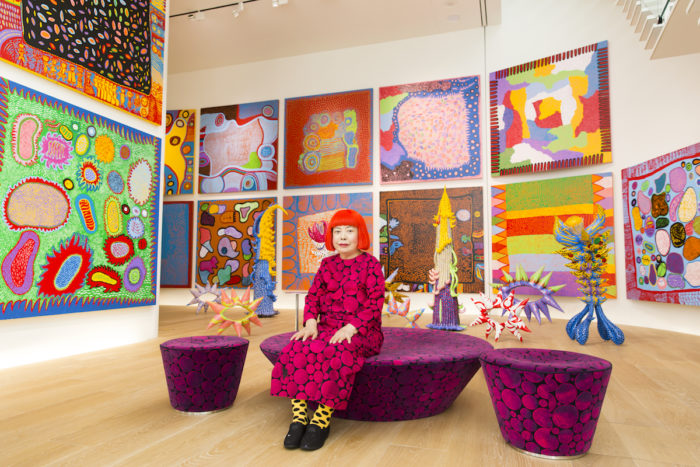
The Seattle Art Museum’s (SAM) exhibition of “Infinity Mirrors,”colorful artworks by artist Yayoi Kusama’s, has been celebrated for its playfulness, but Kusama’s personal statements about self-obliteration through repetition of patterns within her work sparks deeper contemplation.
Kusama’s art is widely celebrated through critical acclaim, sold-out exhibits and an explosion of selfies on social media taken in her unique installations.
But other Japanese and Japanese American women in the art field also reflected on Kusama’s journey, including her struggles with mental health and being an artist of color.
“I never experienced the suppression that Kusama experienced as a rebellious female artist of her generation in Japan. So I marvel at her strength, ambition and boldness in getting to the US and then working within the male-dominated NY art scene,” said Chiyo Ishikawa, the Susan Brotman Deputy Director for Art and Curator of European Painting & Sculpture at SAM.

Kusama was born in 1929 in Matsumoto, amongst the Japanese Alps. Kusama excelled at art studies as a child, but also suffered delusional attacks. She saw her papers, floors and walls covered in dots.
She developed sewing skills in her teen years when she made parachutes for the Japanese Imperial army war effort, and then went on to study traditional Japanese painting at a university in Kyoto.
She had some success exhibiting her pattern-based paintings in Japan before deciding to come to the United States to pursue her art career. Kusama found the name of Seattle art writer Kenneth Callahan at the United States embassy and wrote to him, asking for advice on how to show her work here, said Mika Yoshitaki, curator of the Yayoi Kusama exhibit at the Hirschhorn Museum. Kusama made an agreement with Zoe Dusanne — Seattle’s first modern art gallerist — who had previously shown other notable Northwest artists of color including James Washington, Jr., Paul Horiuchi and (my father) George Tsutakawa.
Kusama exhibited in Seattle in 1957 and stayed for about a year before heading to Greenwich Village in New York, where she continued to create very large pattern-based paintings. In the 1960s, she started incorporating a wide range of styles, including sculptures made of hundreds of soft, sewn phallus pieces; infinity mirrors that reflected small lights within box structures and collages inspired by her very close relationship with artist Joseph Cornell.
She also produced performance art on the streets of New York City, where she painted her famous dots on nude participants, drawing attention to her stance against United States involvement in the Vietnam War.
“Thinking of being a woman and Japanese, how she established her reputation in her early 30s in the avant-garde movement in New York during the 1960s is impressive. As is her international recognition as one of the most important living artists to come out of Japan,” said Seattle-based glass and media artist Etsuko Ichikawa, who was also born in Japan.
After 16 years abroad, Kusama returned to Japan in 1973. She eventually checked herself into a mental institution, where she has chosen to live today near her large Tokyo studio with its many assistants. She also has published several books of poetry and essays.
Kusama has said the relentless patterns in her work reflect the visions she continues to have. Those patterns also offer her solace, artists have noted.
“I am captivated by her theme of self-obliteration and reminder that human life is only a small dot in the universe,” Ishikawa said. “I appreciate the dogged routine of Kusama’s practice, and the comfort she finds in mechanical repetition.”
“Even since she was institutionalized, she keeps working, making art to this day,” said Elizabeth Jameson, another Seattle visual artist of Japanese heritage.
Jameson noted that many become artists while finding comfort in the act of creating.
“I think of my mom, who came to the U.S. from Japan at about the same time, an army wife. She started making art to keep herself intellectually stimulated with the often-mundane life on an army base,” Jameson said.
Tamiko Thiel, an artist originally from Seattle who also creates immersive virtual installations, said Kusama’s art has a visceral effect.
“Her mirrored infinite installations speak to me most strongly as floating virtual spaces in which one loses one’s sense of having a concrete, physical body,” said Thiel, now based in Germany.
Kusama’s mirror and light sculptural boxes are often popular, especially with the large public audiences that her exhibitions have attracted in recent years. But Jameson is most impressed with the repetitive white “infinity net” painting series that Kusama has created throughout her long career.
“They are so simple, yet so intense.” Jameson said. “There is a push/pull effect and they pulsate. I would say they are both conflicted and complex. They are still fresh today.”
While many reviewers are captivated by what appears to be whimsy, knowledge of Kusama’s struggles with her mental condition offers another positive and sublime angle to her work.
“I’m most inspired by her enormous productivity and with her unstoppable force and willpower,” said Etsuko Ichikawa. “Her commitment and obsession to create is intense.”
“It’s the original sculptures, paintings and drawings from ‘50s through ‘70s that have the intense weight and depth of her mental condition and are really powerful and captivating. They give me a chill,” said Junko Yamamoto, a notable Seattle painter.
“Her seminal role in pop and conceptual art, her work in a broad range of media from painting and literature to environments and performance, her prolific output and dedication to her work over seven decades in spite of illness and limited acceptance all stand out as remarkable achievements,” said Susan Kunimatsu, a Seattle arts writer. “She has waited too long to be discovered.”
Going to “Infinity Mirrors”
The Seattle Art Museum exhibition of “Infinity Mirrors” continues through September 10. Advance tickets are sold out, but a limited number of same day tickets are available.


Thanks for your page! Your share information it helped me alot! I pray for you to be happy and successful in your life.